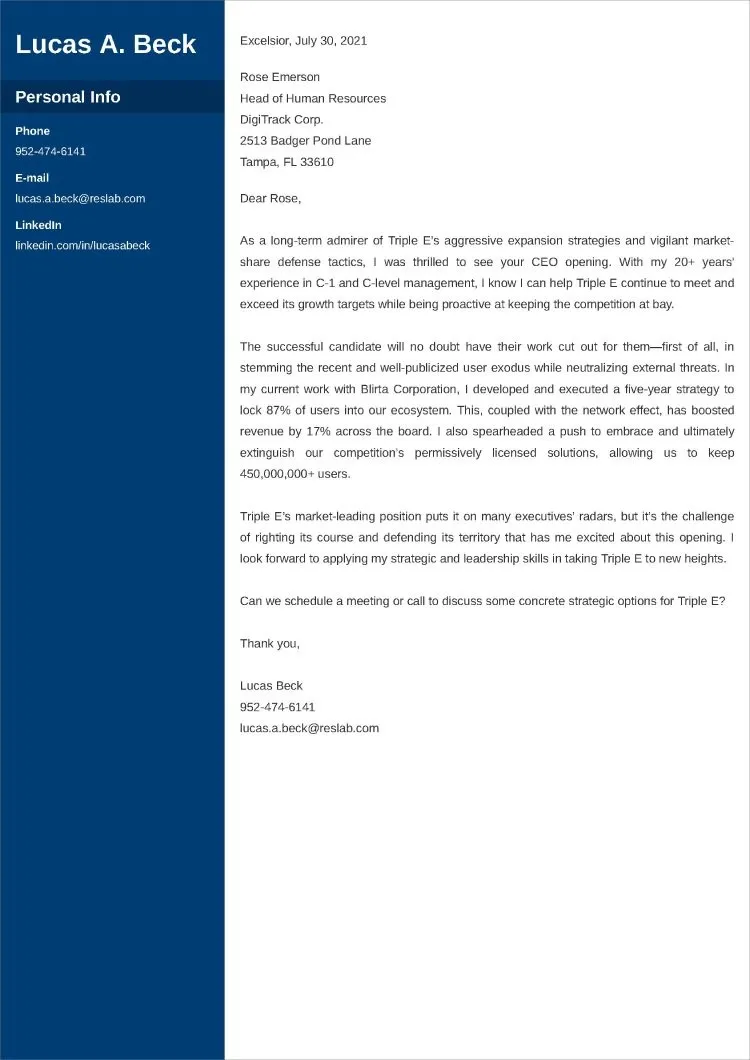Cover Letter Samples Executive Unveiling the Secrets
The executive job market is fiercely competitive. Landing your dream role requires more than just a strong resume. It demands a compelling cover letter that immediately grabs attention and highlights your unique qualifications. This article unveils the secrets to crafting executive cover letters that set you apart from the competition. We’ll delve into essential components, provide actionable tips, and showcase examples to guide you in creating a cover letter that secures interviews and opens doors to your next career move. Get ready to transform your application and unlock your potential.
Understanding the Power of Executive Cover Letters
An executive cover letter is not merely a formality; it’s your first opportunity to make a strong impression. Unlike resumes, which offer a snapshot of your experience, cover letters allow you to tell a story, connect with the hiring manager on a personal level, and demonstrate how your skills and experience align with the specific requirements of the role. This powerful tool provides a platform to showcase your leadership qualities, strategic thinking, and ability to drive results, ultimately paving the way for you to stand out in the job search.
Why Executive Cover Letters Are Crucial
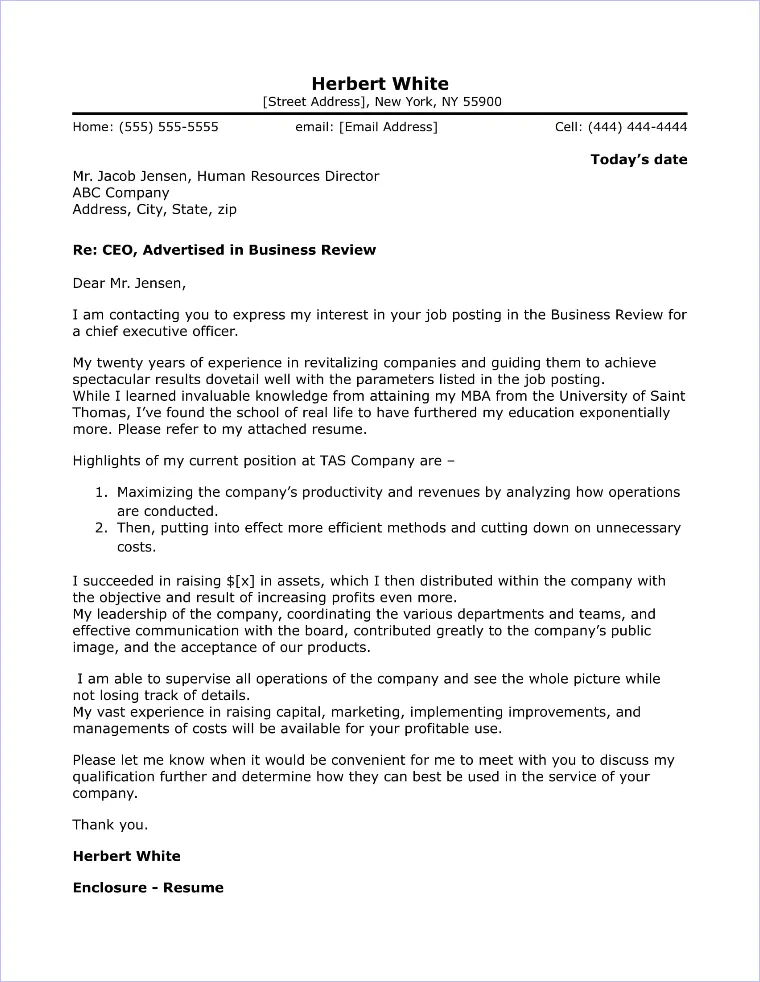
Executive cover letters are crucial because they provide context to your resume. They explain why you’re the ideal candidate for a specific position and demonstrate your understanding of the company’s needs. A well-crafted cover letter can address any potential concerns a hiring manager might have, such as gaps in your employment history or a shift in your career focus. Furthermore, it showcases your communication skills and attention to detail, which are highly valued in leadership roles. It allows you to personalize your application.
Key Components of a Stellar Cover Letter
Creating a successful cover letter is about mastering several key components. Each element plays a vital role in presenting you as the best choice for the job. When you integrate the following components, your cover letter will demonstrate your value, grab the attention of the hiring manager, and increase the chance of receiving an interview opportunity. Let’s explore how to create the most effective executive cover letter.
Header and Contact Information
Your cover letter should start with a professional header that includes your name, title, phone number, email address, and LinkedIn profile URL. Ensure your contact information is up-to-date and easily accessible. Following the header, include the date and the hiring manager’s name and title if known, along with the company’s name and address. Proper formatting demonstrates professionalism and attention to detail, crucial for an executive position. Use a clean and simple font such as Arial or Calibri.
Professional Greeting
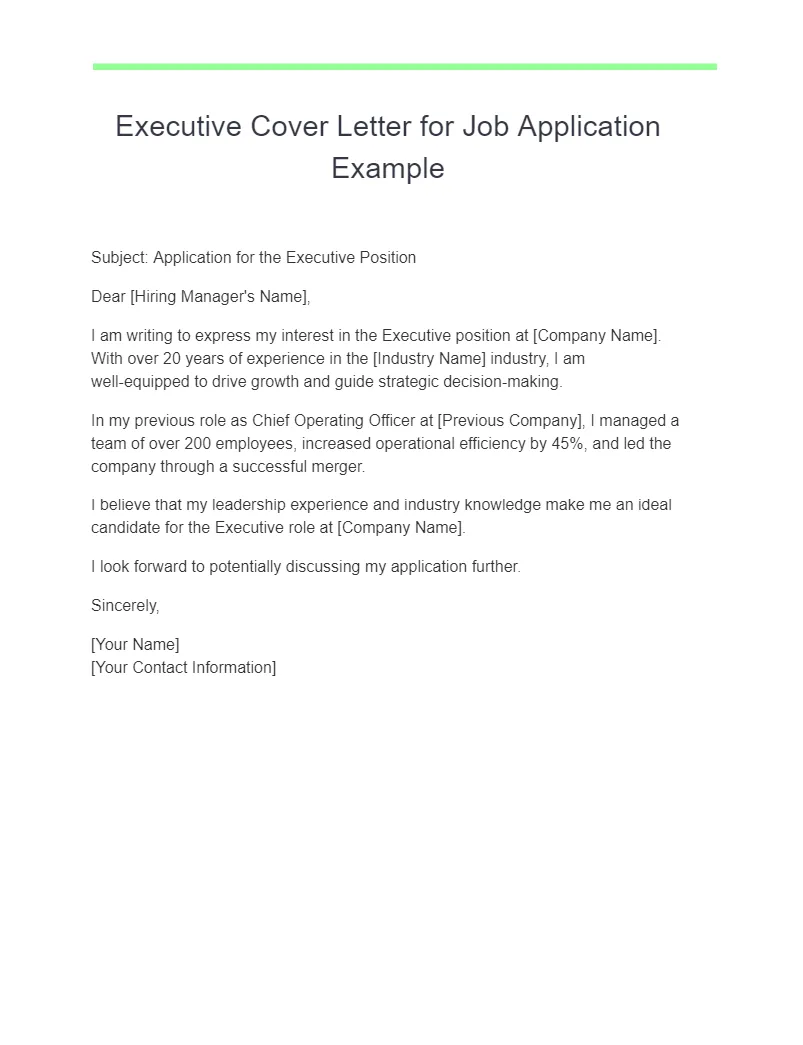
Address the hiring manager by name whenever possible. A personalized greeting shows that you’ve taken the time to research the company and the specific role. If the hiring manager’s name isn’t available, using a general salutation like “Dear Hiring Manager” is acceptable, but always try to find the specific name on LinkedIn or the company website to make a better impression. A personalized greeting immediately grabs the attention of the reader.
The Opening Paragraph Grab Attention
The opening paragraph is your chance to hook the reader. Start with a compelling statement that captures their interest. Consider mentioning a key achievement, your passion for the company’s mission, or a mutual connection. Clearly state the position you’re applying for and how you learned about the opportunity. This paragraph sets the tone for the entire letter, so make it impactful and tailored to the specific role. It immediately tells the reader why you’re an excellent fit.
Highlighting Achievements and Skills
Instead of merely listing your responsibilities, focus on your accomplishments and quantify your achievements. Use the STAR method (Situation, Task, Action, Result) to illustrate how you’ve solved problems, led teams, and delivered results in previous roles. This demonstrates your ability to drive business success. Showcase the skills most relevant to the job description, aligning your experience with the company’s needs and showing them how you can improve business operations and meet their goals.
Quantifiable Results Demonstrating Impact
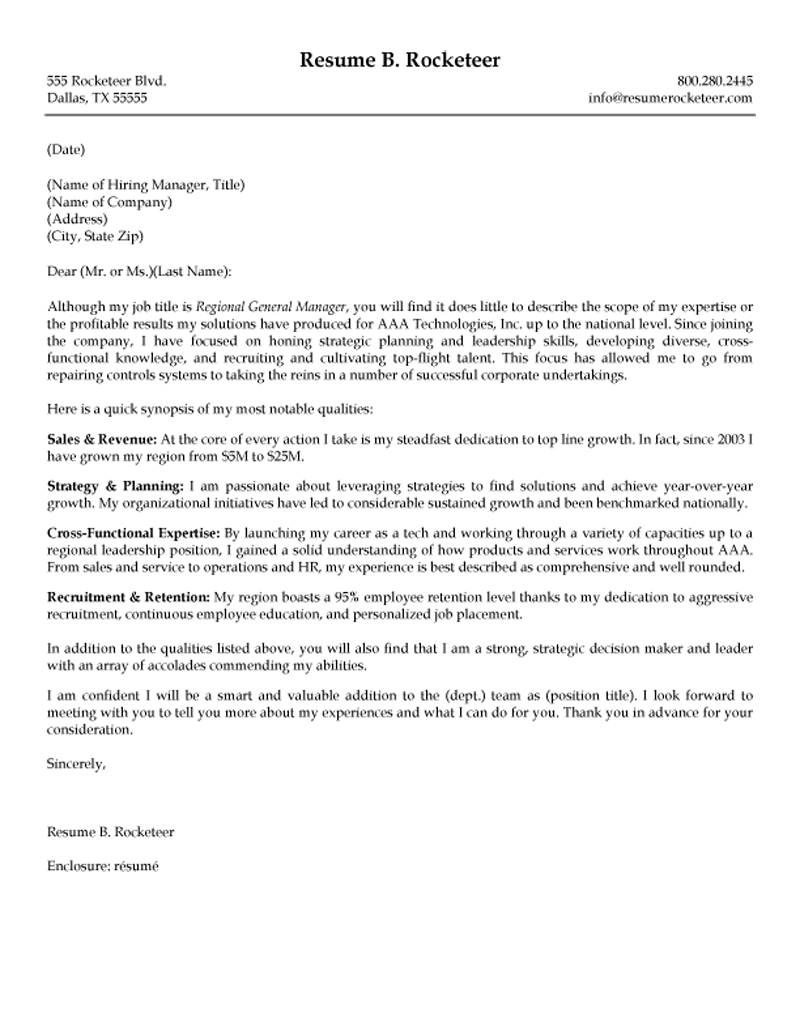
Always quantify your achievements whenever possible. Instead of saying, “Increased sales,” state “Increased sales by 20% in one year.” Use numbers, percentages, and data to showcase your impact. Highlight how you’ve improved efficiency, reduced costs, increased revenue, or achieved other measurable outcomes. Quantifiable results provide concrete evidence of your value and demonstrate your ability to deliver tangible results. This gives the hiring manager concrete proof of your achievements.
Tailoring Your Letter Matching the Job
Customize each cover letter to the specific job description and company. Research the company’s values, mission, and recent initiatives. Show how your skills and experience align with their needs and goals. Use keywords from the job description throughout your letter. This targeted approach demonstrates that you’ve carefully considered the role and are genuinely interested in the opportunity, which can greatly improve your chances of being selected for an interview. Make sure that your skills align with the job description.
Showcasing Leadership and Management Experience
Executive roles demand strong leadership abilities. Highlight your experience leading teams, developing strategies, and managing budgets. Provide examples of how you’ve motivated employees, fostered a positive work environment, and achieved organizational goals. Demonstrate your ability to make strategic decisions, solve complex problems, and drive innovation. Include examples of how you have successfully created team initiatives and fostered team growth and leadership.
Action Verbs Making Your Letter Dynamic
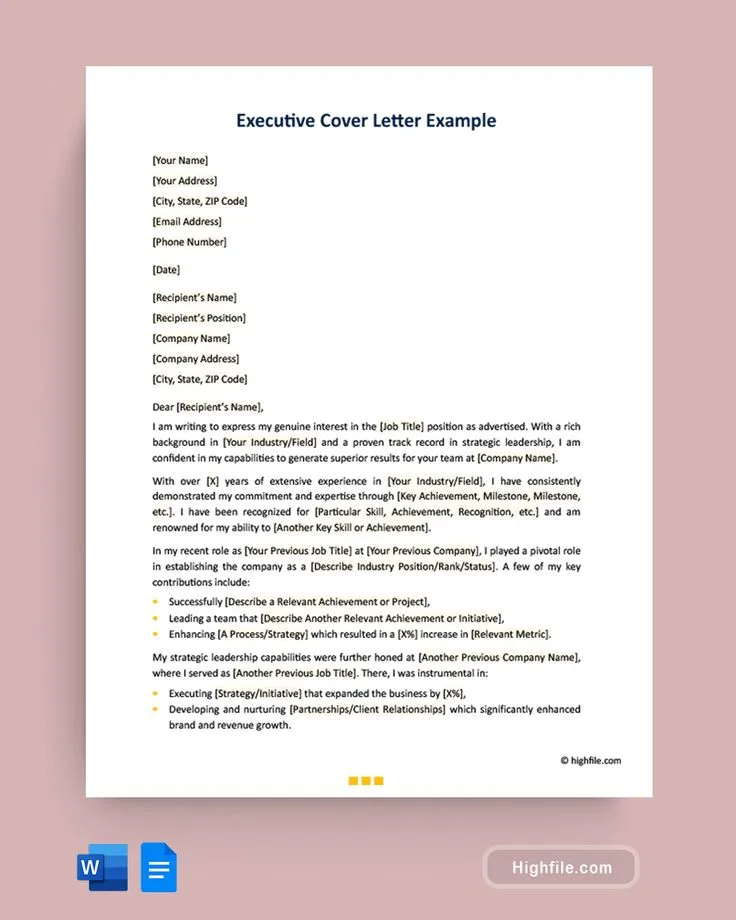
Use strong action verbs to describe your accomplishments and responsibilities. Start your sentences with words like “Led,” “Managed,” “Developed,” “Implemented,” “Increased,” and “Achieved.” Action verbs make your letter more dynamic and engaging, highlighting your accomplishments and showing how you’ve made a difference in previous roles. They also help to make your experience more attractive to the recruiter, making your letter more impressive and effective.
Addressing Employment Gaps and Transitions
If you have employment gaps or career transitions, address them proactively. Explain the reasons behind the gaps or transitions honestly and briefly, focusing on what you’ve learned and how you’ve grown. If you’ve taken time off for personal or professional development, highlight these activities. Frame any potential concerns positively, demonstrating resilience and a commitment to continuous learning. Make the recruiter feel more confident and comfortable with the choices you’ve made.
The Closing Paragraph and Call to Action
End your cover letter with a strong call to action. Express your enthusiasm for the opportunity and reiterate your interest in the role. Thank the hiring manager for their time and consideration and state your availability for an interview. Provide your contact information once more. A well-crafted call to action demonstrates your eagerness and professionalism, increasing the likelihood of a positive response and showing them that you’re serious about the job.
Proofreading and Formatting for Perfection
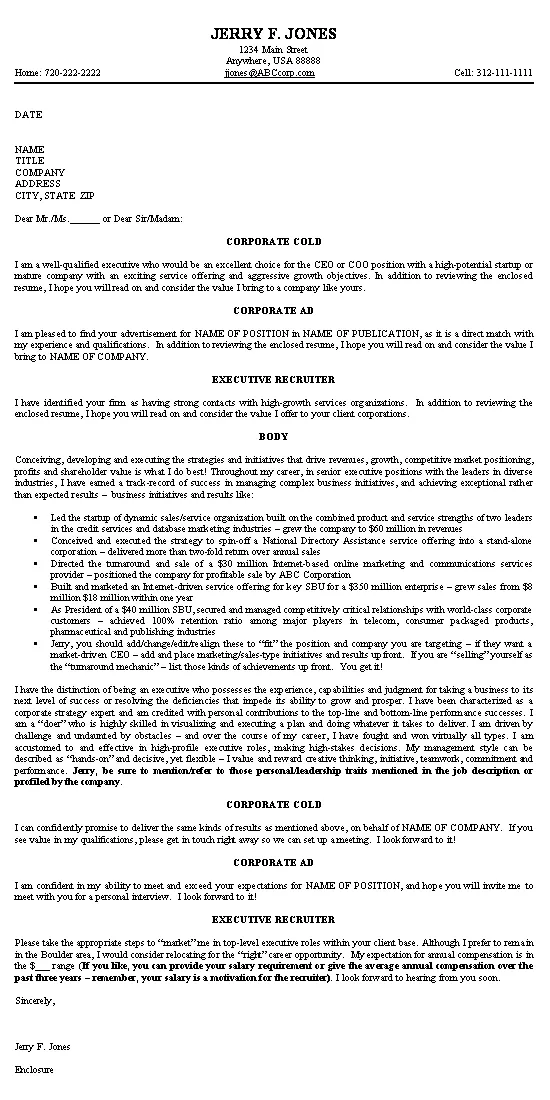
Before submitting your cover letter, proofread it carefully for any errors in grammar, spelling, or punctuation. Ensure the formatting is consistent and professional. Use a clear and easy-to-read font and maintain consistent spacing. Have someone else review your letter to catch any mistakes you might have missed. A polished and error-free cover letter demonstrates your attention to detail and professionalism, which are critical for executive positions. Get some help to improve the overall quality of your cover letter.
Common Mistakes to Avoid
Several common mistakes can undermine an executive cover letter. Avoiding these pitfalls can significantly improve your chances of success. These common errors include using generic language, focusing on responsibilities instead of accomplishments, and ignoring the use of keywords. Let’s examine the specific problems that can happen, and how you can avoid them to create an effective cover letter.
Generic Letters The Kiss of Death
Avoid using a generic cover letter that can be sent to multiple companies. Tailor each letter to the specific job and company, demonstrating your understanding of their needs and your genuine interest in the opportunity. Generic letters lack impact and fail to show that you’ve taken the time to research the role or the company. Always personalize your cover letters.
Focusing on Responsibilities
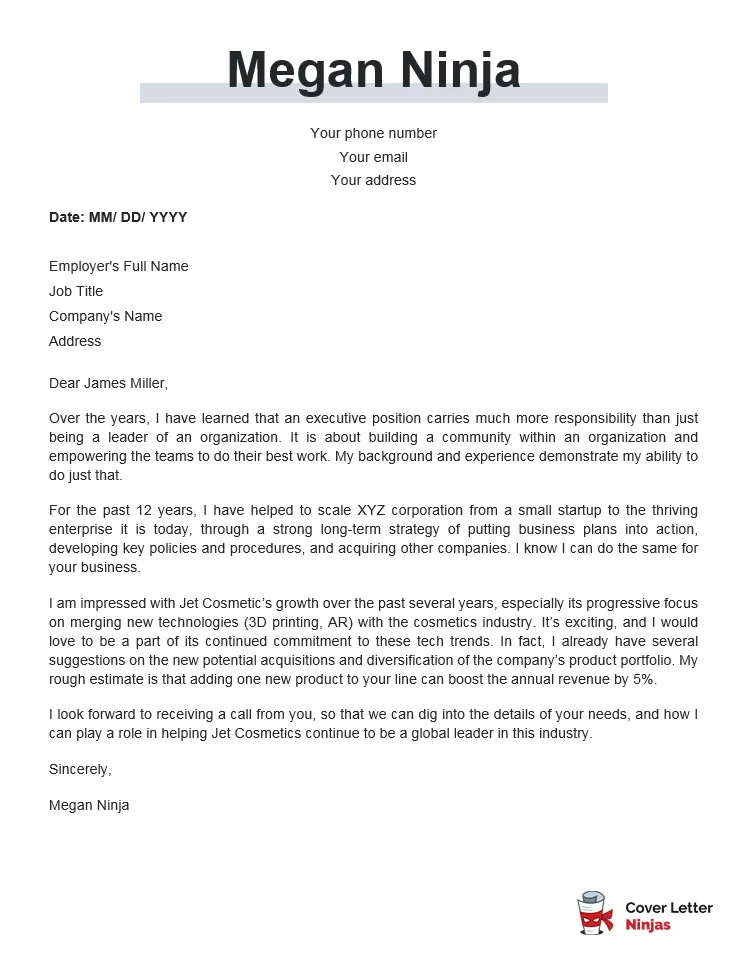
Instead of simply listing your responsibilities, highlight your accomplishments and quantify your achievements. Focus on how you’ve solved problems, delivered results, and made a positive impact in previous roles. The hiring manager doesn’t need to know what you were tasked with doing; they need to see what you accomplished. Make sure you show what you were able to do, and what impact it created.
Ignoring Keywords
Carefully review the job description and incorporate relevant keywords throughout your cover letter. Use these keywords naturally to demonstrate your understanding of the role and align your skills and experience with the company’s needs. Make sure you avoid any keyword stuffing, as this will make your letter less effective. Optimize your cover letter to be more successful.
Examples of Powerful Executive Cover Letters
Reviewing cover letter samples can help you get a better understanding of how to structure and write a compelling letter. Here are some brief examples to use as guides for different executive positions. Make sure you tailor your cover letter to fit the specific job and company.
Letter for a CEO Position
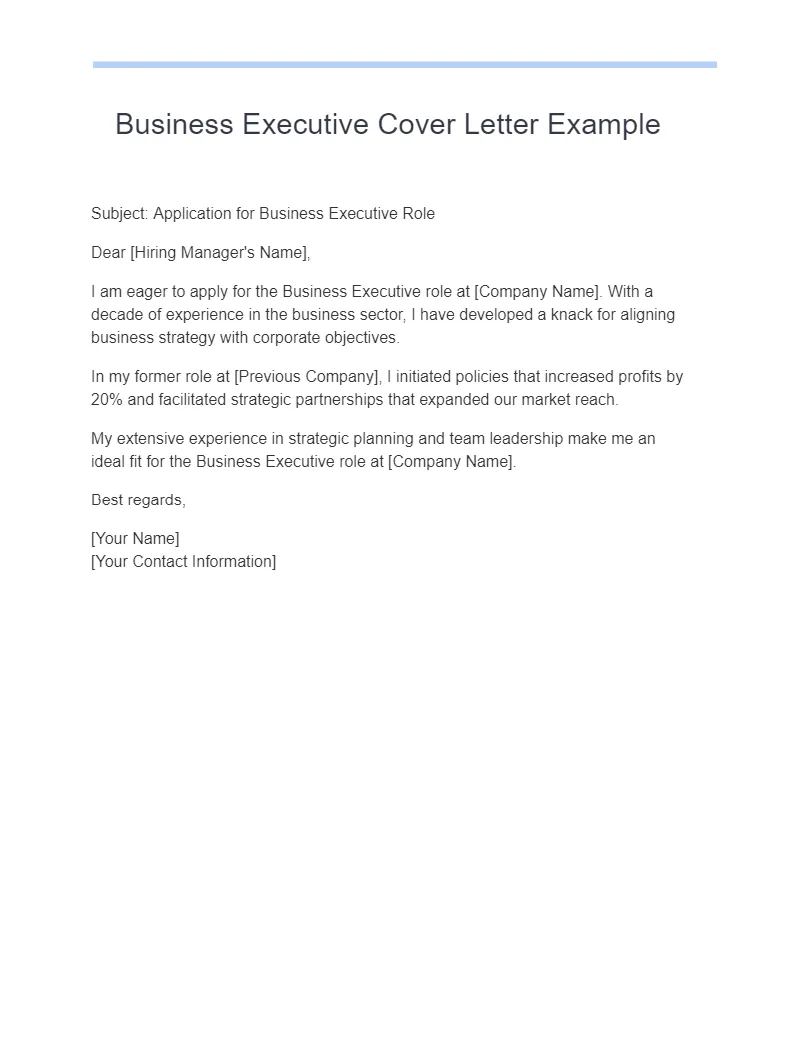
When applying for a CEO position, your cover letter should showcase your strategic vision, leadership experience, and ability to drive organizational growth and profitability. Highlight your achievements in leading and growing businesses, improving financial performance, and developing and implementing successful strategies. Show your strong skills in leadership, management, and communication.
Letter for a CFO Role
A CFO cover letter should emphasize your financial expertise, experience in financial planning and analysis, and ability to manage financial risk and ensure compliance. Highlight your experience in financial management, budgeting, and forecasting. Provide examples of how you’ve improved financial performance, reduced costs, and ensured financial stability. Emphasize your financial acumen and how you can help the company grow.
Letter for a Senior Management Position
A senior management cover letter should highlight your leadership skills, management experience, and ability to drive results. Focus on your accomplishments in leading teams, developing strategies, and achieving organizational goals. Highlight your strong communication, problem-solving, and decision-making skills. Provide evidence of your previous successful strategies.
Final Thoughts Crafting Your Winning Letter
Crafting a compelling executive cover letter takes time and effort, but the investment is well worth it. By following these tips and tailoring your letter to each specific opportunity, you can significantly increase your chances of landing an interview and securing your next leadership role. Remember to highlight your achievements, quantify your results, and demonstrate your unique value proposition. Good luck with your executive job search and the creation of the perfect cover letter!
